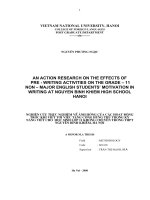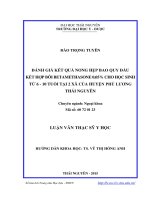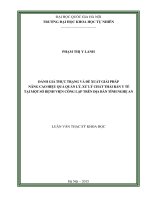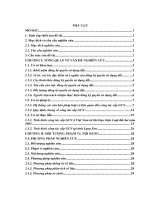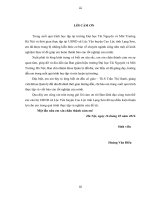Đánh giá thực nghiệm giáo trình “english file beginner student’s book third edition” dùng cho học sinh tiếng anh không chuyên tại một trường dự bị đại học ở việt trì
Bạn đang xem bản rút gọn của tài liệu. Xem và tải ngay bản đầy đủ của tài liệu tại đây (556.52 KB, 96 trang )
VIETNAM NATIONAL UNIVERSITY, HANOI
UNIVERSITY OF LANGUAGES AND INTERNATIONAL STUDIES
FACULTY OF POST-GRADUATE STUDIES
**********
VŨ THỊ HỒNG LUYẾN
THE EMPIRICAL EVALUATION OF THE COURSEBOOK
“ENGLISH FILE BEGINNER STUDENT’S BOOK
– THIRD EDITION” FOR NON-ENGLISH MAJOR STUDENTS
AT A PREPARATORY SCHOOL IN VIET TRI
(Đánh giá thực nghiệm giáo trình “English File Beginner Student’s
Book - Third Edition” dùng cho học sinh Tiếng Anh không chuyên
tại một trường dự bị đại học ở Việt Trì)
M.A. MINOR PROGRAM THESIS
Field
: English Teaching Methodology
Code
: 8140231.01
Hanoi, 2018
VIETNAM NATIONAL UNIVERSITY, HANOI
UNIVERSITY OF LANGUAGES AND INTERNATIONAL STUDIES
FACULTY OF POST-GRADUATE STUDIES
**********
VŨ THỊ HỒNG LUYẾN
THE EMPIRICAL EVALUATION OF THE COURSEBOOK
“ENGLISH FILE BEGINNER STUDENT’S BOOK
– THIRD EDITION” FOR NON-ENGLISH MAJOR STUDENTS
AT A PREPARATORY SCHOOL IN VIET TRI
(Đánh giá thực nghiệm giáo trình “English File Beginner Student’s
Book - Third Edition” dùng cho học sinh Tiếng Anh không chuyên
tại một trường dự bị đại học ở Việt Trì)
M.A. MINOR PROGRAM THESIS
Field
: English Teaching Methodology
Code
: 8140231.01
Supervisor : Assoc. Prof. Dr. Ho Ngoc Trung
Hanoi, 2018
DECLARATION
I certify that the work contained in this thesis is the result of my own
research, and this thesis has not been submitted for any degrees at any other
universities or institutions.
Hanoi, November 2018
Signature
Vu Thi Hong Luyen
Approved by Supervisor
Assoc. Prof. Dr. Ho Ngoc Trung
Date: ………………………….
ACKNOWLEDGEMENTS
First and foremost, I would like to express my deepest gratitude to my
supervisor, Assoc. Prof. Dr. Ho Ngoc Trung for his useful comments and
continuous support of my study, for his patience, encouragement, enthusiasm
and immense knowledge. His guidance helped me tremendously in all the
time of research and writing of this thesis.
I would also like to thank my school leaders and colleagues for their
support and sharing the workload so that I could wholeheartedly focus on the
study and get it completed.
Finally, I would like to express my profound gratitude to my parents,
my spouse, and to all of my friends for providing me with unfailing support
and continuous encouragement throughout my years of study and through the
process of researching and writing this thesis.
This accomplishment would not have been possible without all of them.
Thank you!
Hanoi, November 2018
Signature
Vu Thi Hong Luyen
ABSTRACT
The present study evaluates the coursebook “English File Beginner
Student’s Book – Third Edition” by Christina Latham-Koenig, Clive Oxenden
(Oxford University Press, 2014) for non-English major students at a
preparatory school in Viet Tri in terms its suitability to the objectives of the
course, students’ needs and current teaching and learning method. 150 nonEnglish major students and 8 teachers who were using this coursebook were
invited to answer the questionnaires, and two groups of three or four students
were chosen randomly together with 8 teachers to take part in the interviews.
Data were analyzed both quantitatively and qualitatively. Findings revealed
that the coursebook fundamentally met the course’s objectives and students’
needs, and fit in with the current teaching and learning method, though there
were still minor unsuitable parts that need adaptation. The result of this study
would benefit both teachers and learners who work with this material for
better use in the future.
Key words: coursebook, textbook, material, coursebook evaluation,
empirical evaluation, English File Beginner Students’ Book, non-English
major.
LIST OF TABLE
Table 4.1: Teacher’s assessment of students’ English level at the
beginning of the course.........................................................30
Table 4.2: Learners’ purposes of learning English.................................31
Table 4.4: Students’ ability to communicate in English about the topics
in the coursebook..................................................................35
Table 4.5: Students’ and teachers’ evaluation of the language elements in
the coursebook......................................................................40
Table 4.6: Students’ and teachers’ evaluation of the skills in the
coursebook............................................................................41
Table 4.7: Students’ suggestions on the proportion of the skills.............42
Table 4.8: Teachers’ suggestions on the proportion of the skills.............42
Table 4.9: Effectiveness of the teaching and learning interactions used
with the coursebook..............................................................46
Table 4.10: The frequency of the teaching aids used with the coursebook
...............................................................................................47
Table 4.11: Students’ and teachers’ evaluation on the methodology of the
coursebook............................................................................48
LIST OF CHARTS
Chart 4.1: Students’ age..........................................................................28
Chart 4.2: Students’ background of learning English.............................29
Chart 4.3: Students’ self-assessment of their English level at the
beginning of the course.........................................................30
Chart 4.5: Students’ progress after the course........................................36
Chart 4.6: Students’ and teachers’ evaluation of the topics of the
coursebook............................................................................39
Chart 4.7: The appropriateness of the coursebook with students’ learning
purposes.................................................................................43
Chart 4.8: Students’ and teachers’ overall rating of the coursebook......51
Chart 4.9: Students’ and teachers’ judgement on the time allocation for each
unit.........................................................................................52
TABLE OF CONTENT
DECLARATION...............................................................................................i
ACKNOWLEDGEMENTS..............................................................................ii
ABSTRACT.....................................................................................................iii
LIST OF TABLES............................................................................................iv
LIST OF CHARTS...........................................................................................v
CHAPTER 1: INTRODUCTION.....................................................................1
1.1. Rationale.....................................................................................................1
1.2. Aims of the study........................................................................................2
1.3. Scope of the study......................................................................................3
1.4. Research questions.....................................................................................3
1.5. Significance of the study............................................................................4
1.6. Structure of the study.................................................................................4
CHAPTER 2: LITERATURE REVIEW..........................................................6
2.1. Text book, coursebook and material...........................................................6
2.1.1. Definitions..................................................................................................................
2.1.2. Roles of materials in ELT classrooms........................................................................
2.2. Coursebook evaluation...............................................................................9
2.2.1. Definitions of coursebook evaluation........................................................................
2.2.2. Approaches to coursebook evaluation.......................................................................
2.2.3. Criteria for coursebook evaluation.........................................................................1
2.3. Needs analysis..........................................................................................17
2.4. Previous studies on coursebook evaluation..............................................19
CHAPTER 3: RESEARCH METHODOLOGY.............................................22
3.1. The setting................................................................................................22
3.1.1. English teaching and learning context....................................................................2
3.1.2. Course material.......................................................................................................2
3.1.3. Course objectives.....................................................................................................2
3.1.4. Course assessment...................................................................................................2
3.2. Research methodology.............................................................................24
3.2.1. Participants..............................................................................................................2
3.2.2. Research instruments...............................................................................................2
3.2.3. Data collection procedure.......................................................................................2
3.2.4. Data analysis methods.............................................................................................2
CHAPTER 4: FINDINGS AND DISCUSSION.............................................28
4.1. About the learners.....................................................................................28
4.1.1. Learners’ English learning background..................................................................2
4.1.2. Learners’ English level............................................................................................2
4.1.3. Learners’ purposes of learning English...................................................................3
4.1.4. Learners’ favorite learning styles............................................................................3
4.2. The suitability of the coursebook to the objectives of the course............33
4.2.1. Data collected from the questionnaire.....................................................................3
4.2.2. Data collected from semi-structured interviews......................................................3
4.2.3. Discussion and conclusion......................................................................................3
4.3. The suitability of the coursebook to students’ needs................................38
4.3.1. Data collected from questionnaires.........................................................................3
4.3.2. Data collected from semi-structured interviews......................................................4
4.3.3. Discussion and conclusion......................................................................................4
4.4. The suitability of the coursebook to the current teaching and learning methods
...........................................................................................................46
4.4.1. Data collected from questionnaires.........................................................................4
4.4.2. Data collected from semi-structured interviews......................................................4
4.4.3. Discussion and conclusion......................................................................................5
4.5. General evaluation and suggestion for further use of the coursebook.....50
4.5.1. General evaluation..................................................................................................5
4.5.2. Suggestions for further use......................................................................................5
CHAPTER 5: CONCLUSION........................................................................54
5.1. Conclusion................................................................................................54
5.1.1. The suitability to the objectives of the course..........................................................5
5.1.2. The suitability to students’ needs.............................................................................5
5.1.3. The suitability to current teaching and learning methods.......................................5
5.2. Limitations and suggestions for further studies.......................................56
REFERENCES................................................................................................57
APPENDIXES..................................................................................................I
APPENDIX 1: QUESTIONNAIRE FOR STUDENTS...................................I
APPENDIX 2: QUESTIONNAIRE FOR TEACHERS...................................X
APPENDIX 3: TRANSCRIPT OF TEACHER INTERVIEW....................XIX
APPENDIX 4: TRANSCRIPT OF STUDENT INTERVIEW..................XXIII
CHAPTER 1: INTRODUCTION
This chapter presents a general overview of the study with specific
references to the rationale, the aims of the study, research questions, scope of
the study, significance of the study, and structure of the study.
1.1. Rationale
Coursebooks are generally considered as the core materials and “the
visible heart of any ELT program” (Sheldon, 1988). They play a lot of
essential roles in ELT such as a source of learning and teaching activities, a
resource of learners’ self-study, a syllabus, and a support for inexperienced
teachers (Cunningsworth, 1984). However, coursebooks are usually designed
and written for the general market, thus they cannot fit in all teaching and
learning contexts with possibly inappropriate cultural and social contents or
teaching methods. That is the reason why selecting a suitable coursebook for
a particular teaching course is a challenging. It also takes on special
importance because the chosen coursebook would determine the teaching and
learning process and reflect the value of the educational institution. Therefore,
the need of evaluating coursebooks should also take on the same importance.
It helps identify the strong points and weak points of the materials so that
future decisions can be made about whether or not to keep using the materials,
or adapting them to better fit learners’ needs and learning objectives.
However, very few of such a retrospective evaluation has been undertaken in
comparison with the predictive evaluation, which is carried out before using
the materials to decide if they are to be selected (Ellis, 1997). In terms of
retrospective evaluation, the evaluation of the materials that have actually
been used, there are two ways of evaluating: impressionistic and empirical
evaluations. While the former involves evaluation based on observation of
1
learners’ engagement and enthusiasm in activities and contents of the book, it
is more commonly conducted than the latter one, which relates to collecting
data in a more systematic way.
The importance and the inadequate quantity of empirical evaluations of
coursebooks triggers a desire in the researcher to apply an evaluation of this
type to the coursebook “English File Beginner Student’s Book – Third
Edition” for non-English major students in a preparatory school in Viet Tri.
Since English was incorporated into the school program as a compulsory
subject, there has not been an official coursebook approved by the Ministry of
Education for the school. It is the teaching staffs who select the book that they
consider best fit the objectives of the course and corresponds to students’
needs based on predictive evaluation of the books. The coursebook “English
File Beginner Student’s Book – Third Edition” is currently used as the main
coursebook in the school after several choices of different materials. After a
year of piloting the book, the researcher, also the teacher who has worked
with this book, finds it quite interesting to students with a lot of authentic
videos and meaningful tasks; however, it also reveals several problems which
renders it difficult to meet students’ needs and achieve the ultimate goal of
teaching and learning program. To present, there has not been any careful and
systematic evaluation of this material. That is the reason why the researcher
desires to perform an empirical evaluation on this book to examine the
validity of the predictive evaluation of the teachers in English groups of the
school and that of her personal impressionistic evaluation, as well as to
evaluate the appropriateness of the book for learners, learning and teaching
context and purposes.
2
1.2. Aims of the study
This study mainly aims at evaluating the coursebook “English File
Beginner Student’s Book – Third Edition” by Christina Latham-Koenig, Clive
Oxenden (Oxford University Press, 2014), which is used for non-English
major students at a preparatory school in Viet Tri to determine whether it
meets the requirements of the course in terms of the objectives, students’
needs and methodology.
1.3. Scope of the study
In terms of book evaluation, Cunningsworth (1984) listed a number of
important evaluating criteria in the quick-reference checklist for evaluation
such as: aims and approaches, design and organization, language content,
skills, topic, methodology, teachers’ book, practical considerations. Besides,
evaluation can be conducted predictively or retrospectively for different
purposes (Ellis, 1997). Due to the time constraint and the length limitation a
master’s thesis, the subject of the evaluation is narrowed down to one type of
retrospective evaluation, the empirical evaluation of the coursebook “English
File Beginner Student’s Book – Third Edition” for non-English major students
at a preparatory school in Viet Tri with main focus its suitability to the
course’s objectives, students’ needs and current methodology.
1.4. Research questions
The study will be conducted to answer the following three questions:
- To what extent does the coursebook “English File Beginner Student’s Book
– Third Edition” meet the objectives of the course?
- To what extent does the book meet students’ needs?
- To what extent is the book suited to the current teaching and learning
methods?
3
1.5. Significance of the study
The findings of the thesis would contribute to the school’s decision of
using the coursebook “English File Beginner Student’s Book – Third Edition”
or parts of the book again, or substituting and adapting inappropriate parts of
book with more suitable ones, or replacing the book with another one. Thus, it
would benefit both teachers and learners who work with the material.
Teachers would have a chance to apply the most appropriate materials and
teaching methods for their students with different levels whereas students
could find the materials that best fit their needs and their learning purposes.
The result will also be valuable for teachers and learners in other preparatory
schools in the country with similar teaching and learning context
1.6. Structure of the study
The study consists of five chapters:
Chapter 1: Introduction - presents a general overview of the study with
specific references to the rationale, the aims of the study, research questions,
scope of the study, significance of the study, and structure of the study.
Chapter 2: Literature Review - provides theoretical basis for the study with
the detailed discussion about some relevant theories related to textbook,
coursebook, material, material evaluation and need analysis.
Chapter 3: Research methodology – describes the methodology employed
in the study.
Chapter 4: Findings and discussion – includes a detailed description of the
findings as well as full explanation and interpretation of these findings.
Chapter 5: Conclusion – gives conclusion and limitations of the study and
then provides suggestions for further study.
4
1.7. Summary
Chapter 1 has introduced the rationale, aims and scope of the study.
Research questions, significance and structure of the study were also
included. The importance of coursebook and coursebook evaluation, together
with the inadequate quantity of empirical evaluation of the coursebook
“English File Beginner Student’s Book – Third Edition” used for non-English
major students at a preparatory school in Viet Tri have triggered the
researcher’ desire to conduct the study. The main focus of the study is on the
suitability of the coursebook to the course objectives, students’ needs and
current teaching and learning methods. Therefore, this study aims at
evaluating this coursebook to find out if it meets the course objectives,
students’ needs and current teaching and learning methods. The findings of
the study will help the school to make decision about keep using the book or
replace it or part of it by more suitable materials.
5
CHAPTER 2: LITERATURE REVIEW
This chapter provides theoretical basis for the study with the detailed
discussion about some relevant theories related to textbook, coursebook,
material, material evaluation and need analysis.
2.1. Text book, coursebook and material
2.1.1. Definitions
Teaching materials are an indispensable component of any language
teaching curricula. There are a number of ways researchers defined this
concept but they shared the same viewpoint that materials can be anything
used to facilitate language teaching and learning (Littlejohn 1998, Tomlinson
1998, McGrath 2002). Littlejohn (1998) and Tomlinson (2011) viewed
materials in various forms which can be students’ books, workbooks,
teacher’s guides, videos, CDs, DVDs, lesson plans, website activities and
more. Similarly, McGrath (2002) provided a broad sense of materials in
which he explained that they could be “realia” (real objects) or presentations
(drawings or photographs). He also added textbooks, worksheets, computer
software and recordings as sources of materials. Among these forms, textbook
is considered the official material and “the visible heart of any ELT programs”
(Sheldom, 1988). It plays an important role of teaching a particular subject in
schools and colleges and serves a basis of study for students and a primary
teaching instrument for teachers (Oxfordlearnersdictionaries.com, 2008).
As a type of teaching materials, a coursebook is defined as “a textbook
that
students
and
teachers
use
as
the
basic
of
a
course”
(Collinsdictionary.com, 2018). In other words, it is used to refer to a book
“used by students when they do a particular course of study”
(Dictionary.cambridge.org, 2018). In accordance with the dictionary
6
definition, Ur (1996) and Tomlinson (2011) explain that coursebooks function
as the core materials for a language-learning course that a teacher and each
student has a copy. It aims to provide as much as possible in one book and
serves as the only book which learners basically use during a course. A
coursebook usually includes exercises not only on language elements like
grammar, vocabulary, pronunciation but also on functions and skills of
reading, writing, listening and speaking.
From the above view of “materials”, “textbook” and “coursebook”, it
can be pointed out that text book and coursebook are types of materials and
these three terms can be used interchangeably in ELT teaching and learning
context.
2.1.2. Roles of materials in ELT classrooms
According to Richards and Rogers (2001) as cited in Ulaş Kayapinar
(2009), coursebooks play an indispensable part in the curriculum because they
specify content and define coverage for syllabus items. They play multi
essential roles in ELT such as a source of learning and teaching activities with
systematic and standard knowledge of grammar, vocabulary, pronunciation,
etc., a resource of learners’ self-study, a syllabus in accordance with
determined learning objectives, and a support for inexperienced teachers
(Cunningsworth, 1995). Coursebooks also help standardize instruction, frame
the language contents, and provide language models and practice activities for
teachers and students to follow in class (Ur, 1996). Ur adds more advantages
of coursebooks. For example, they provide available and appropriate texts and
exercises for most learners and classes. They are also the most economic and
convenient ways of providing teaching and learning materials for both
teachers and learners. Thus, the use of coursebooks is more and more popular
among universities, private schools and some state schools. It is the ready7
made syllabi in the ready-made coursebooks that are preferred by both school
administrations and teachers of English. Besides, coursebooks provide
opportunities for learners to practice the target language in the classroom
before they use it in real life situations.
However, coursebooks as preplanned instruction materials have some
possible disadvantages. According to Richards and Renandya (2002), as cited
in Ulaş Kayapinar (2009), coursebooks fail to present real-life language
models and contextualize language activities. They fail to address linguistic
competence as well as to teach idioms in everyday language. Lack of equity
in gender representation and the inadequate cultural understanding
encouragement are also among the disadvantages of coursebooks. Ur (1996)
adds the following drawbacks of coursebooks. Firstly, coursebooks are
inadequate in that every class and learner has their own learning needs and a
coursebook cannot supply these satisfactorily. Secondly, coursebooks are
irrelevant because the topics dealt within the books may not necessarily be
interesting for the class. Coursebooks may lead to boredom and lack of
motivation on the part of the learners. Also, they do not cater for variety of
levels of ability and knowledge that exist in most classes. Moreover, although
coursebooks are considered as the magical instruction tool for language
teachers, highly structured coursebooks may even lead to the de-skilling of
teachers (Hutchinson & Torres 1994 as cited in Osman Dülger 2016).
In conclusion, on one hand, coursebooks prove to be very advantageous
for both school administrations, language teachers and students with available
syllabi and already designed texts and tasks which are suitable for a large
portion of language learners. On the other hand, coursebooks reveal some
limitations such as inadequacy, irrelevance, inauthenticity. That is the reason
why any coursebooks should be evaluated to see whether or not they match
the school curriculum and learners’ needs and interests.
8
9
2.2. Coursebook evaluation
2.2.1. Definitions of coursebook evaluation
Coursebook evaluation is of great significance as it seeks to identify the
strengths and weaknesses’ of the books and helps to make decisions about
adapting the materials or adopting new ones. In order to conduct the
evaluation of a coursebook, it is necessary to understand what the process of
evaluation involves. There are a number of definitions of evaluation provided
by researchers. According to Tomlinson (2011), coursebook evaluation is an
attempt to measure the potential value of the coursebooks. It involves making
judgements about the effects of coursebooks on such agents as learners,
instructors, administrators who use them through such features of the books as
credibility, validity, flexibility, etc. Coursebook evaluation is also defined by
Rea-Dickins and Germanie (1994) as “the means by which we can gain a
better understanding of what is effective, what is less effective and what
appears to be no use at all”. Effective evaluation relies on asking appropriate
questions and interpreting the answers to them (Cunningsworth, 1995).
In summary, coursebook evaluation is the process of collecting data,
giving judgement on the effectiveness of books based on the collected data to
make precise decisions of effectively using the materials or replacing them.
2.2.2. Approaches to coursebook evaluation
Material evaluation is “a dynamic process which is fundamentally a
subjective, rule-of-thumb activity" where "no neat formula, grid, or system
will ever provide a definitive yardstick" (Sheldon, 1988). There are a variety
of approaches and criteria of coursebook evaluation which vary according to
the ELT contexts. Administrators and instructors should choose the most
10
suitable criteria to evaluate coursebooks, considering the specific teaching and
learning contexts.
The following sets out a range of approaches to coursebook evaluation
which all tend to evaluate coursebooks on four main aspects, including the
internal content, the aims and approaches, the supporting sources and the
physical appearance of the coursebook.
Ellis’s approach (1997)
According to Ellis (1997), there are two main types of coursebook
evaluation: predictive evaluation and retrospective evaluation. A predictive
evaluation is designed to help teachers decide what coursebooks to use
whereas a retrospective evaluation may be conducted once the book is used to
find out if the material matches the learners’ need and current teaching
methodology. Predictive evaluation, according to Ellis, can be carried out in
two principal ways. One involves teachers relying on evaluations carried out
by experts specializing in coursebook evaluation. Alternatively, teachers can
carry out their own predictive evaluations by making use of various checklists
and guidelines available in the literature. Another kind of evaluation –
retrospective evaluation – is carried out while a coursebook is in use (whilstuse evaluation) or after it has been used (post-use evaluation). There are two
ways of retrospective evaluations: impressionistic and empirical one. While
the impressionistic evaluation is based on observation of learners’
engagement and enthusiasm in activities and contents of the book, empirical
one relates to “collecting data in a more systematic manner” (Ellis, 1997). To
conduct empirical evaluation, teachers use “end-of-course questionnaires to
judge the effectiveness of their teaching, including the material used”;
therefore, it is often more objective and reliable than other kinds of evaluation
as it is based on users’ feedback. Such an evaluation provides information that
can be used to determine whether the material is worth using again. In
11
addition, Ellis (1997) states that retrospective evaluation is a good way of
testing the validity of a predictive evaluation.
Tomlinson’s approach (2003)
Another approach of evaluating coursebooks is proposed by Tomlinson
(2003) with a three-stage process of evaluation: pre-use evaluation, whilst-use
evaluation and post-use evaluation. The first stage, pre-use evaluation,
according to Tomlinson (2003), is “impressionistic and consists of a teacher
flicking through a book to gain a quick impression of its potential value”. It
involves assessing the potential value of materials for their users, including a
quick scan of a book’s physical appearance and content pages to get an
impression of its potential value. The second stage, whilst-use evaluation,
involves evaluating materials in use. This can be more reliable than pre-use
evaluation, as it involves deeper evaluation of the content of materials and
makes use of classroom observation and feedback from the users although,
according to Tomlinson (2003), this stage includes controversial issues about
what exactly can be measured. The criteria seem to be general and some (e.g.
credibility of tasks, achievement of performance objectives, motivating power
of the materials, etc.) are not easy to measure. However, he also suggests that
these criteria “can be estimated during an open-ended, impressionistic
observation of materials in use but greater reliability can be achieved by
focusing on one criterion at a time”. They can be measured by different
methods. For example, to measure the motivating power of the materials he
suggests ‘noting such features as student eye focus, proximity to the
materials, time on task and facial animation’ (Tomlinson, 2003). In the last
stage of evaluation in this approach, post-use evaluation, most evaluators tend
to seek answers to such questions as: What is the impact of the coursebook on
learners? What is its impact on teachers? And what is its impact on
administrators? According to Tomlinson (2003), this stage is probably the
12
most valuable stage in the evaluation process as it involves measuring the
effects of the materials on users after the coursebook has been used. Also, as
Cunningsworth (1995) points out, post-use evaluation is useful in helping to
decide whether to continue using a coursebook or not in the future.
Littlejohn’s approach (1998 & 2011)
The third major approach for coursebook evaluation is suggested by
Littlejohn (1998 & 2011). He suggested a three-level evaluation checklist
including: (1) What is there? (2) What is required of users? and (3) What is
implied? At the first level, there are questions about the physical properties of
the coursebook. These cover publication date, intended audience, physical
aspects (number of pages, paper quality, artwork, etc.), and are similar to the
ones in Tomlinson (2003). Level 2 focuses on the language learning activities
and tasks in the coursebook to see what teachers and learners using the
coursebooks need to do. It moves slightly deeper into an analysis of what is
assumed to be the most important aspect of coursebooks. At the third level,
there are questions on the approach, philosophy and aims of the coursebook.
Littlejohn points out that his levels of evaluation move from more objective
criteria to less objective ones. The first level is the most objective while the
third level is the least.
McGrath’s approach (2002)
The fourth approach to coursebook evaluation is suggested by McGrath
(2002). He points out the aspects which need evaluating in a two-stage
process of systematic materials evaluation. They are ‘first-glance’ evaluation
and ‘in-depth’ evaluation. Each stage consists of a series of criteria by which
to evaluate the coursebook. The ‘first glance’ evaluation has four steps. In
step 1 – practical considerations, features evaluated in this step include:
availability, cost, and the levels of the book which are available. If these are
judged satisfactory, the evaluation proceeds to step 2 – support for teaching
and learning. Features assessed at this step include the teacher’s book and
13
how well it relates to the student book, supporting resources (e.g. cassette
recordings, photocopiable worksheets, etc.). If all these are satisfied, the
evaluator proceeds to step 3 - context relevance. At this stage the evaluator
assesses the suitability of the coursebook in terms of aims, syllabus, length
and its suitability for learners’ proficiency level, age and background. If all of
these meet the requirements, the evaluator goes further to step 4 - learner
appeal. This step involves considering the appeal of the book to learners. This
is mainly related to the appearance of the book. The evaluation starts from the
first sub-step. If a coursebook meets all of the key criteria for each step, the
process continues with the next one. If it does not meet the key criteria in any
sub-step, the process stops and the coursebook is rejected. If all of the abovementioned key criteria are met, the in-depth evaluation step is carried out to
assess the coursebook in detail.
According to McGrath (2002), the in-depth evaluation tends to address
the following points:
- The aims and content of the book
- What they require learners to do
- What they require the teacher to do
- Their function as a classroom resource
- Learner needs and interests
- Learner approaches to language learning
- The teaching-learning approach in the teacher’s own classroom
McDonough and Shaw’s approach (1993 & 2003)
Another important approach for coursebook evaluation is suggested by
McDonough and Shaw’s (1993 & 2003) with three stages: external
evaluation, internal evaluation and overall evaluation. This implies that
evaluation is continuous and never static, as the criteria can be changed to suit
different teaching and learning contexts. External evaluation is similar to
McGrath’s (2002) ‘first-glance evaluation’, Tomlinson’s (2003) ‘pre-use
evaluation’ and Littlejohn’s (1998 & 2011) ‘level 1 evaluation’. It focuses on
the intended audience, the proficiency level, the context, the organization and
14
presentation of units, the author’s views and methodology, the learning
process and the learner, and the physical appearance. Issues of layout and
design and local availability, supporting resources (teacher’s book, audiovisual materials, etc.) are also included in this stage. The internal evaluation is
concerned with the content, including grading and sequencing. This stage
seems to resemble McGrath’s (2002) ‘in-depth evaluation’ and Tomlinson’s
(2003) ‘whilst-use evaluation’.
In general, each approach to coursebook evaluation, as mentioned
above, has its own strengths and weaknesses. Evaluators should choose or
even devise an approach which is the most principled, systematic and suitable
for their context. In the researcher’s opinion, it is also important for evaluators
to combine approaches, in order to offset the weaknesses of one approach
with the strengths of others. The present study uses a mixed approach, mainly
based on Ellis’s framework (1997), though modified, with evaluation criteria
from other authors.
2.2.3. Criteria for coursebook evaluation
From different approaches to the evaluation of coursebooks, there are
also different sets of criteria for evaluating coursebooks.
Criteria proposed by Hutchinson and Water (1987)
Hutchinson and Water (1987) proposed a checklist of material
evaluation including items related to subjective and objective analysis of the
book such as: audience, aim, content, methodology, price and its availability.
Audience: This part of the checklist consists of some questions related
to information about the learners such as their age, sex, nationalities, study or
work specialism, language background and interests.
Aim: Evaluators need to consider if the aims and objectives of the
coursebook match those of the course/ school program.
Content: The questions covered in this part involve the language
description, language point, macro-skill and their proportion, micro-skill,
15

